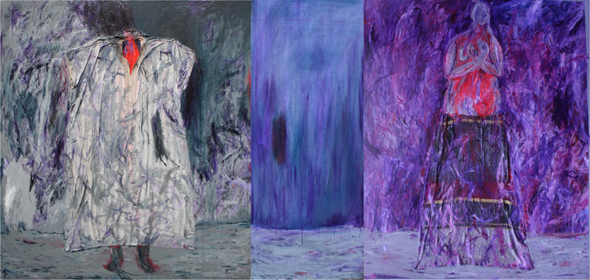A bold young painter signals new direction in Indonesian fine art
Annie Tucker
Between My Mother and Father There’s Me Ahmad Soleh |
In one room, a stained Arabic tunic is plastered to the wall with red flame burning from its neck where a head should be. Across from it, in the midst of a smoky haze, a tattered skirt floats inches off the ground. If you look closely a thin red thread attaches the two articles of clothing, forming a ghostly couple. In another room, an indistinct figure with bloodied legs cradles a decapitated bearded face, proclaiming ‘I love my father’s head.’ In a third room, a door swings on its hinges, on one side the naked figure of a man forever on his way out and on the other the figure of a woman, dressed in a purple gown sprinkled with stars, enacting her faithful return.
These haunted rooms were part of The Imitation Journey, the recent solo exhibition of an emerging young artist named Khadir Supartini held at Tujuh Bintang Art Space in Yogyakarta from 11-15 April 2012. The show featured large-scale paintings, collage, sculpture, and installation, which Khadir described as pieces that ‘are like intermediaries between my feelings and my artistic practice’. The theme of the show is Khadir’s effort to tell the story of his obscure origins and claim an authentic personal creative identity, yet this intimate approach may also prove to be part of a growing claim for fine art’s new role in contemporary Indonesian discourse on identity.
Khadir’s Story
At the heart of Khadir’s story is his absent father. When she was just a teenager, Khadir’s mother, Supartini, left her farming family in the outskirts of Yogyakarta to work in Medina, Saudi Arabia, as a migrant domestic worker. According to family lore, Khadir’s father was a member of the upper-class family for which she worked and over the course of her two and a half year contract the pair fell in love. His family forbade a marriage and Supartini returned home to rural Java. Khadir’s father briefly followed but ultimately returned to the Middle East and cut off all contact with his wife and son, christened Ahmad Abdul Khadir, who was still an infant. When Khadir was in elementary school his mother re-married a Javanese man and moved to her new husband’s home leaving her son behind to be cared for by his grandmother and nearby relatives, occasionally stopping by to check in on him.
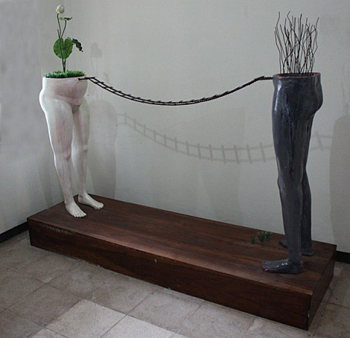 |
Obstinate Spring Ahmad Soleh |
Growing up, in between untamed hours spent hanging out on Marlioboro Street, racing motorcycles, listening to Boomerang and Led Zeppelin and getting drunk with his fellow art school classmates, Khadir had to piece together an image of his father based on the recollections of family and friends, treasuring the few details he discovered as carefully as he treasured the few items his father had left behind – the long tunic he would later collage onto canvas, a pair of sandals. He says, ‘It was difficult to reconstruct an image of my father. All I knew about him was from my neighbours telling me that he was tall.’ When Khadir was in his early twenties, he decided to search for his father and himself got a job as a foreign labourer as close as he could to Medina, in Qatar. After a year of working in ornamental design he was about to set off across the border to Saudi Arabia when his mother became distraught and, via telephone from Indonesia, begged him not to go. He instead returned home to Sleman, took his mother’s name as his own, and began in earnest his life as an artist as Khadir Supartini.
New directions
Khadir’s story is dramatic and compelling, but not necessarily unusual. Approximately one million Indonesian women go abroad as domestic workers each year, and many of them become involved in romantic relationships that are formal and informal, sanctioned and secretive. In certain publicised and upsetting cases, Indonesian women have been the subject of sexual harassment and even rape at the hands of their foreign employers. In other cases, workers’ long separations from their husbands and children, or the formation of bi-cultural families over vast distances, can have negative repercussions on family life.
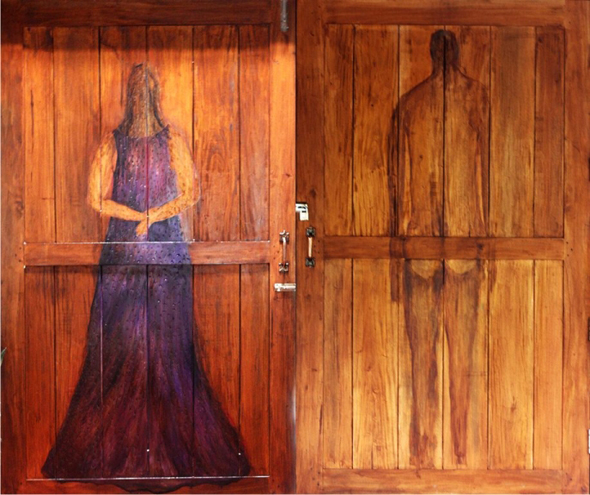 |
Slipping In and Out of Dreams Ahmad Soleh |
However, it is unusual that such a personal story would be chosen as a theme for a solo exhibition of fine art. Autobiographical or confessional artwork remains rare in Indonesia. As journalist Kurnianto described it in his review of the show for The Yogyakarta Daily, the typical Indonesian approach can be described as being one in which ‘Shame should be completely covered up. Don’t put it on display. Even to discuss it is already taboo, especially if the shame involves family problems.’ Some significant Indonesian fine artists have portrayed members of their families in their paintings, such as Affandi’s portraits of himself with his grandchildren, and others have reflected on matters of personal significance, such as Nasirun’s visual meditations on the role of Javanese Muslim spirituality in his life.
A rich body of fine art in Indonesia is highly critical of political and socio-economic oppression, from Raden Saleh’s works resisting Dutch colonial authority up until Entang Wiharso’s post-reformasi NusaAmuk and Taring Padi’s activist art. However, it remains rare for artists to use their work to reveal how socio-political conditions have affected them personally and it is rarer still for an Indonesian fine artist to explore the complex or conflicted psychological aspects of such personal experiences.
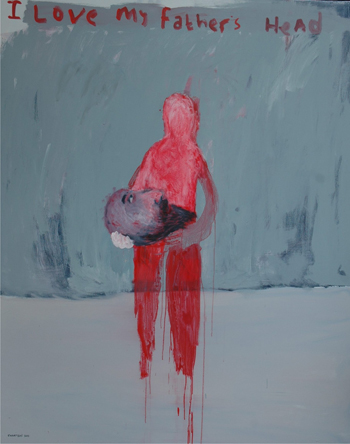 |
I Love My Father’s Head Ahmad Soleh |
In this environment, Khadir’s admission of the details of his background, along with the imagery he uses to express his feelings about it, is uniquely bold. In addition to the paintings described above, Khadir’s exhibition features works with a man’s head smashed inside a urinal, a Middle-Eastern male figure eyeing a sex doll, and a similar figure daydreaming naked amidst clouds of condoms. But it also features Edenic couples in the bloom of love, and a number of abstract expressionist self-portraits. Freud would have a lot to analyse in Khadir’s striking and often poignant combinations of idolatry, accusation, and self-examination. He also might be interested to hear Khadir say openly, as he did in one interview, that one of the song lyrics inspiring the show was the Doors echo of Oedipus: ‘Father I want to kill you, Mother, I want to sleep with you.’
An enthusiastic response
The exhibition has received significant local peer, critical, and media attention, perhaps precisely because it addresses such rarely-discussed issues while bringing a new psychological perspective to familiar problems. On the opening night of Khadir’s solo exhibition, this new approach was hailed as courageous and recognised as a significant development in Indonesian fine art. Rusnoto Susanto, the curator, observed that the collection of works ‘presents a number of personal and social realisations where the will to capture the essence of his direct experience becomes a reference for others.’ Entang Wiharso, in opening the show, said he believed that Khadir had the potential to become a ‘national monument’.
But would Indonesia ever really claim for a national monument a young man who is the product of a bi-cultural and shamefully ‘broken’ home, who speaks in such confessional and conflicted tones? What might such a new direction mean for Indonesian fine art and what might it mean for contemporary Indonesians coming to terms with their own public and private identities? Perhaps, more than ten years after reformasi, which opened the floodgates for creative expression and debate, the interweaving of the personal and the political and the use of confessional or autobiographical material to trigger public dialogue is an idea whose time has come. It may be that the art world will provide an important venue for such a dialogue.
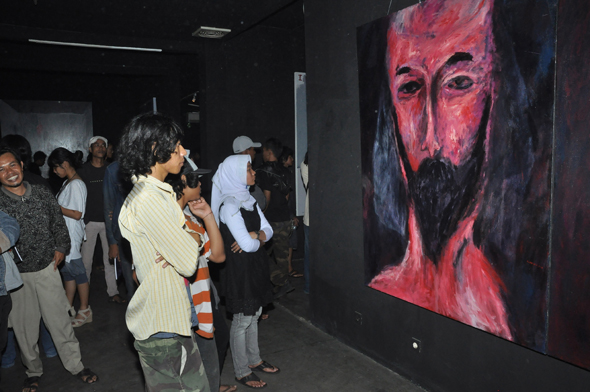 |
Imagining Khadir’s Father Ahmad Soleh |
Perhaps it is more than coincidence that The Imitation Journey came to fruition in tandem with the Jakarta launching of the large-scale travelling exhibit RE.CLAIM, which featured more than 60 Indonesian artists working across the archipelago and internationally. RE.CLAIM was created at the request of Dr Melani Setiawan in celebration and promotion of her new book, Indonesian Art World: 1977-2011. Melani is a significant figure in the art scene, and the book presents many of the photographs she has taken over more than three decades attending events and befriending artists. In opening up her personal archive to the public, she challenged artists to do likewise, to make or display work that reflected the interaction of their creative work with their private lives and incorporated elements from their own personal archives. This show marked one of the first major collections of explicitly autobiographical works by Indonesian artists, many of which culled personal mementos or mined painful personal experiences and connected that pain to past and present artistic projects offered for public consumption. A co-curator of the show, Christine Cocca said that such an event was groundbreaking since 'the term… personal [has a] long and complicated history in Indonesia where the collective is prized over the individual’.
Looking ahead
Meanwhile, Khadir Supartini is back in his studio planning his next solo show. His unusual height and light skin hints at his mixed heritage as he works on a fibreglass sculpture of an imposing head, which at one point he cradles affectionately. He says, ‘the most important capital an artist has is honesty, what he or she feels. You have to take what is closest to you. An artist has to be attuned to a condition or situation. For example, maybe someone is interested in making work about corruption, but the artist doesn’t actually know that much about corruption…to me that’s sort of just like making it up. An artist has to truly dig deep.’
With this perspective Khadir challenges himself and other contemporary Indonesian artists to tell their own stories while pursuing their craft. Rather than protesting for protests sake, or making merely representational paintings, the role of the artist is to take the chance of investigating and revealing the self – family issues, dark urges, and all. Khadir will certainly be an artist to watch as he continues to explore these issues while offering viewers both potent social critique and moving personal imagery.
Annie Tucker (actucker@ucla.edu) works as a writer and research assistant for Elemental Productions, a documentary film company exploring culture and personal experience in Indonesia. She is also a PhD candidate in UCLA’s Department of World Arts and Cultures/Dance.

